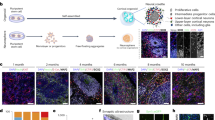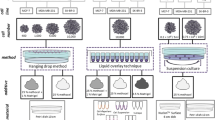Summary
The authors prepared tissue cultures from the following human brain tumours-glioblastoma multiforme, astrocytoma malignum and meningeoma endotheliomatosum. The cytostatic effects of two antibiotics, Actinomycin C (Sanamycin) and Actinomycin D were studied on these cultures. Quantitatively, the results were rated by the determination of the growth inhibition rate and the mitotic index of the explants; qualitatively, by evaluating the alteration of cellular morphology. As compared with the meningiomas, the malignant gliomas reacted more sensitively to both drugs. In the glioma cultures quantitative differences were observed between the responses to both drugs: a higher concentration of AD was required to obtain the same effect as with AC. In the meningioma cultures the identical concentration of both drugs brought about the same effect. The authors discuss the problem of thein vitro testing andin vivo application of chemotherapeutic drugs. They raise the idea of performing a sensitivity test in tissue culture prior to chemotherapy.
Zusammenfassung
Die Autoren haben Gewebskulturen von folgenden menschlichen Hirntumoren gezüchtet: Glioblastoma multiforme, malignes Astrozytom und endotheliomatöses Meningeom. Die Wirkung von zwei Antibiotika, Actinomycin C (Sanamycin) und Actinomycin D, auf diese Kulturen wurden untersucht. Die Ergebnisse wurden quantitativ durch Bestimmung der Wachstums-Hemmungsrate und des Mitosen-Index der Explantate gemessen; qualitativ durch Untersuchung der Änderung der Zellstruktur. Im Vergleich zu den Meningeomen reagierten die malignen Gliome empfindlicher auf beide Medikamente. In den Gliom-Kulturen wurden quantitative Unterschiede hinsichtlich der Reaktion auf beide Pharmaka beobachtet: Man benötigt eine höhere Konzentration von Actinomycin D als von Actinomycin C, um die gleiche Wirkung zu erzielen. In den Meningeom-Kulturen hatte eine identische Konzentration beider Medikamente ungefähr die gleiche Wirkung. Die Autoren besprechen das Problem der in vitro-Testung und in vivo-Anwendung von chemotherapeutischen Mitteln. Sie empfehlen die Durchführung von Empfindlichkeits-Tests in Gewebskulturen vor Beginn einer Chemotherapie.
Résumé
Les auteurs ont préparé des cultures de tissu à partir de tumeur du cerveau de l'homme tels que glioblastome multiforme, astrocytome malin et méningiome endothélial. Les effets cytostatiques de 2 antibiotiques: Actinomycine C — Sanamycine et Actinomycine D ont été étudiés sur ces cultures. Quantitativement, les résultats sont enregistrés par la détermination de l'inhibition de la croissance et de l'index mitotique des prélèvements; qualitativement, par l'évaluation de l'altération de la morphologie cellulaire. Par comparaison avec les méningiomes, les gliomes malins paraissent plus sensibles aux 2 drogues. Dans les cultures de gliome, des différences quantitatives ont été observées dans la réponse aux 2 drogues: une plus forte concentration d'Actinomycine D a été nécessaire pour obtenir le même effet qu'avec l'Actinomycine C. Dans les cultures de méningiome, une concentration identique des 2 drogues atteint à peu près le même effet. Les auteurs discutent le problème tu test in vitro et de l'application in vivo de drogues chimiothérapiques. Ils proposent l'idée de réaliser un test de sensibilité avant les cultures de tissu par chimiothérapie.
Riassunto
Gli autori hanno preparato delle culture di tessuto tumorale cerebrale umano, come di glioblastoma multiforme, astrocitoma maligno e meningioma endoteliomatoso.
Gli effetti citostatici dei due diversi antibiotici, Actinomicina C/Sanamicina e Actinomicina D sono stati studiati su queste culture. Quantitativamente i risultati sono stati valutati dalla determinazione della proporzione di inibizione di crescita e dall'indice mitotico degli esplanti.
Qualitativamente, valutando l'alterazione della morfologia cellulare.
In confronto ai meningiomi, i gliomi maligni reagivano più sensibilmente ai due farmaci. Nelle culture di gliomi si osservavano differenze quantitative nella reazione ai due farmaci: una più alta concentrazione di AD fu necessaria per ottenere lo stesso effetto riscontrato con AC.
Nelle culture di meningiomi la stessa concentrazione dei due farmaci provocò il medesimo effetto.
Gli autori discutono il problema dell'esame in vitro e dell'applicazione in vivo di farmaci chemoterapeutici. Essi sollevano l'ipotesi di effettuare un esame della sensibilità in culture di tessuti preventivamente alla chemoterapia.
Similar content being viewed by others
References
Caspersson, T., S. Farber, G. E. Foley, andD. Killander, Cytochemical observations on the nucleolus-ribosome system. Effects of actinomycin D and nitrogen mustard. Exp. Cell. Res.32 (1963), 529–552.
Cobb, J. P., andD. G. Walker, Effects of actinomycin D on tissue cultures of normal and neoplastic cells. J. Nat. Cancer Inst.21 (1958), 263–277.
— —, Studies on human melanoma cells in tissue culture. I. Growth characteristics and cytology. Cancer Res.20 (1960), 858–866.
Creasy, W. A., Tumor-inhibitory effects of combinations of the vinca alkaloids with actinomycin D. Biochem. Pharm.15 (1966), 367–375.
Easty, P. M., andJ. A. H. Wylie, Screening of 12 gliomata against chemotherapeutic agents in vitro. Brit. J. Med. J.1 (1963), 1589–1592.
Fraccaro, M., A. Mannini, L. Tiepolo, andA. Albertini, Incorporation of tritium-labelled actinomycin in a human cell line. Exp. Cell Res.43 (1966), 136–147.
Gellhorn, A., M. R. Murray, E. Hirschberg, andR. Fricker Eising, In vitro and in vivo effects of chemical agents on human and mouse glioblastoma multiforme. Proc. II. Int. Congr. Neuropathology London (1955);1 (1957), 265–271.
Gullotta, F., Zur in vitro-Diagnostik gliös-mesenchymaler Mischgeschwülste. Dtsch. Z. Nervenheilk.186 (1964), 323–335.
Hirschberg, E., M. R. Murray, E. R. Peterson, andJ. Kream, Enzymatic deamination of 8-azaguanine in normal human brain and in glioblastoma multiforme. Cancer Res.13 (1953), 153–157.
Kersting, G., Die Gewebszüchtung menschlicher Hirngeschwülste. Berlin-Göttingen-Heidelberg: Springer. 1961.
Lassman, L. P., G. W. Pearce, andJ. Gang, The sensitivity of malignant intracranial tumours to vincristin sulphate. In: Proc. 3. internat. Congr. Neurol. Surgery Copenhagen 1965.De Vet, J., ed., p. 748–751. Amsterdam: Excerpta Medica. 1966.
Limburg, H., undM. Krahe, Die Züchtung von menschlichem Krebsgewebe in der Gewebekultur und seine Sensibilitätstestung gegen neuere Zytostatika. Dtsch. med. Wschr.89 (1964), 1–23.
Mueller, G. C., andK. Kajiwara, Actinomycin D and p-fluorophenylalanine, inhibitors of nuclear replication in HeLa cells. Biochim. et Biophys. Acta119 (1966), 557–565.
Mungyerova, G., K. Jacz, J. Kuzma, O. Babusikova, andF. Kalafut, Experiences with malignant brain tumours in clinic and in tissue culture. Acta Neurochirurgica13 (1965), 393–406.
Murray, M. R., E. R. Peterson, E. Hirschberg, andJ. L. Pool, Metabolic and chemotherapeutic investigation of human glioblastoma in vitro. Ann. of New York Acad. Sci.58 (1954), 1147–1171.
—, andA. P. Stout, The classification and diagnosis of human tumors by tissue culture methods. Texas Repts. Biol. Med.12 (1954), 898–915.
Neu, R. L., J. C. Leao, andL. J. Gardner, Effects of actinomycin D and puromycin on chromosomes of cultured human leukocytes. Nature211 (1966), 881–882.
Osokina, L. J., I. P. Fomina iS. M. Navashin, Primenyenyije razlicsnich modifikacij metoda kulyturi kletok cseloveka pri izucsenyii protyvoopuchelovüch antibiotikov. Antibiotiki11 (1966), 614–619.
Pantaleakis, P. N., andG. M. Meteyko, Effects of actinomycin D on the nucleoli of different cells in vitro. J. Cell Biol.31 (1966), 154 A.
Pályi, I., D. Áfra ésE. Csanda, Gliomák viselkedése szövettenyeszetben. Ideggyógyászati Szemle14 (1961), 225–237.
Sellei, C., S. Eckhardt ésL. Németh, Daganatos betegségek gyógyszeres kezelése. Budapest: Medicina. 1968.
Simon, G., Chemotherapie der malignen Hirngeschwülste. In: Handbuch der Neurochirurgie, Bd. IV (H. Olivecrona undW. Tönnis). Berlin-Heidelberg-New York: Springer. 1967.
Timofejewskaja, E. A., Gyejsztvije aurantina, chrizomalina, aktinomicinov C i K., na opucholevie cseloveka i kulyture tkanyi. Vopr. Onkol.12 (1966), 65–69.
Wright, J. C., J. P. Cobb, S. L. Gümport, F. M. Golomb, andD. Safadi, Investigation of the relation between clinical and tissue-culture response to chemotherapeutic agents on human cancer. New England J. Med.257 (1957), 1207–1211.
— — —,D. Safadi, D. G. Walker, andF. M. Golomb, Further investigation of the relation between the clinical and tissue culture response to chemotherapeutic agents on human cancer. Cancer15 (1962), 284–293.
Zanoni, G., Zum Problem der zytostatischen Therapie bei Hirntumoren. Schweizer Archiv f. Neurologie, Neurochirurgie und Psychiatrie100 (1967), 441–456.
Author information
Authors and Affiliations
Additional information
The authors express their thanks to Mrs. Dr.I. Szentiványi for her valuable assistance.
Rights and permissions
About this article
Cite this article
Gazsó, L.R., Áfra, D. Study on the effect of actinomycins in tissue cultures from human brain tumours. Acta neurochir 21, 139–151 (1969). https://doi.org/10.1007/BF01540921
Issue Date:
DOI: https://doi.org/10.1007/BF01540921




